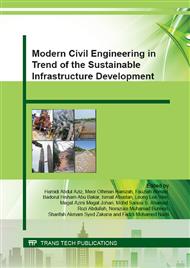p.327
p.333
p.339
p.345
p.351
p.357
p.363
p.369
p.375
Volume-Delay Function in Trip Assignment
Abstract:
Four-stage demand models are the most popular travel demand forecasting models. Trip assignment which is the last stage in the four-stage demand modelling is a key element in travel demand forecasting process. Traffic assignment model is used to assign travel demands into the road network and predict network flows that are associated with future planning scenarios based on the estimates of link travel times. In order to calculate travel time between origin and destination, a function presenting the relationship between link delays and link flows is used. This function is known as Volume-Delay Function (VDF) and it is the fundamental component of equilibrium trip assignment models. This study aims to investigate and improve VDFs for heterogeneous traffic at different type of arterial roads in Malaysia by using the road network in Balik Pulau, Penang as a case study. Primary data such as traffic volume and speed are collected at three types of arterial roads, which are the principal arterial, minor arterial and collectors to derive the parameters required in the VDFs. In this study, the most well-known and most widely-used volume-delay function which is known as the BPR function developed by the U.S. Bureau of Public Roads was investigated and calibrated using the transportation planning software, EMME 4.1.3. The calibrated functions are then validated with field data. The output from this research is very important as better understanding of VDFs can produce better estimate of link travel times and hence better planning for future scenarios.
Info:
Periodical:
Pages:
351-356
Citation:
Online since:
October 2015
Authors:
Keywords:
Price:
Сopyright:
© 2015 Trans Tech Publications Ltd. All Rights Reserved
Share:
Citation:


